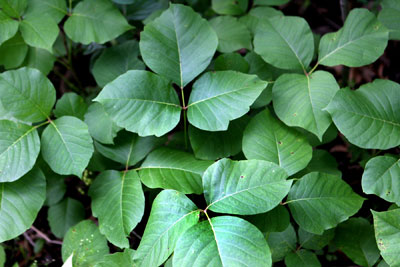Poison Oak & Poison Ivy Cures & Causes

A powerful plant-based oil secretion called urushiol causes all rashes from poison oak, poison ivy and poison sumac. Urushiol is enormously potent! An amount the size of the head of a pin of this toxic oil is enough to cause a rash in 500 people. While poison oak rashes are rarely severe enough to be incapacitating, they are very uncomfortable and may require treatment.
How it spreads
Fluid in the blisters that may from contracting poison Ivy/Oak do not contain the toxic chemical, urushiol. If the blisters break, the fluid will not result in spreading of the poison oak. Scratching other parts of the body with contaminated fingernails, however, may spread poison oak, and urushiol can remain under the nails for several days unless the nails are extensively cleaned.
A person who has washed thoroughly and has changed into clean clothing will not spread poison oak. The only way to get poison oak is through direct contact with the toxic resin, for example by coming in contact with a contaminated person who has not washed properly or changed into clean clothes.
Urushiol oil does not evaporate and can remain active for a year or longer after coming into contact with up on tools, clothing, animal fur, etc
Symptoms
The main symptom of poison oak, ivy, or sumac is an extremely itchy, red rash that appears within 24 to 72 hours of exposure. The rash often appears streaked, and may develop into oozing blisters. In general, the skin rash though uncomfortable, is not serious, and usually resolves on its own in one to two weeks. However, a doctor should be contacted immediately if you are highly sensitive or have the following symptoms:
- Swelling of the face or throat
- Rash on the genitals
- Swelling or rash that covers more than one third of your body
- Rapidly spreading rash
- Signs of a bacterial infection, such as pain, increased redness, or pus
Severity
The severity of poison oak skin reaction depends on the degree of patient sensitivity, the amount of exposure, and on which body parts are exposed. Very sensitive body parts, including the eyes, lips, and genitals exposed to poison oak sap will experience a more severe reaction.
Mid cases can last 5 to 12 days. More severe cases can last up to 30 days or longer.
Treatments
Minor Irritation: For mild cases, run hot water over the affected areas, as hot as you can stand. This will seem counterintuitive, since heat increases the itching and cold soothes it. Under hot water the itching will briefly become very intense and then will stop for several hours, as if the nerves responsible for conveying the sensation to the brain become overloaded and quit. As soon as the itching starts again, go back to the hot water. If you do this conscientiously the whole reaction will complete itself quickly and your skin will return to normal much faster than it would otherwise.
Moderate to Heavy Irritation: For more severe itching, pain, oozing, and swelling, over-the-counter anti-itch treatments that contain zinc acetate or, zinc oxide are known to be beneficial for the treatment on poison ivy or oak. In several cases a physician can prescribe antihistamine creams, tablets, and in rare cases, shots. Surprisingly, diaper rash ointments can also be effective treatments for poison oak rash because they contain zinc oxide. Ointments containing zinc oxide help to dry the skin and protect it from damage and infection.
Zinc Oxide ointments with a 20% or higher active ingredient have been proven to be helpful in drying the oozing and weeping of poison ivy, poison oak, and poison sumac.
A common misconception is to use bleach on the rash as a treatment. Do not wash the body with any concentration of liquid bleach after a poison oak exposure.Bleach will further irritate inflamed skin , causing more redness and pain to sensitive body parts.